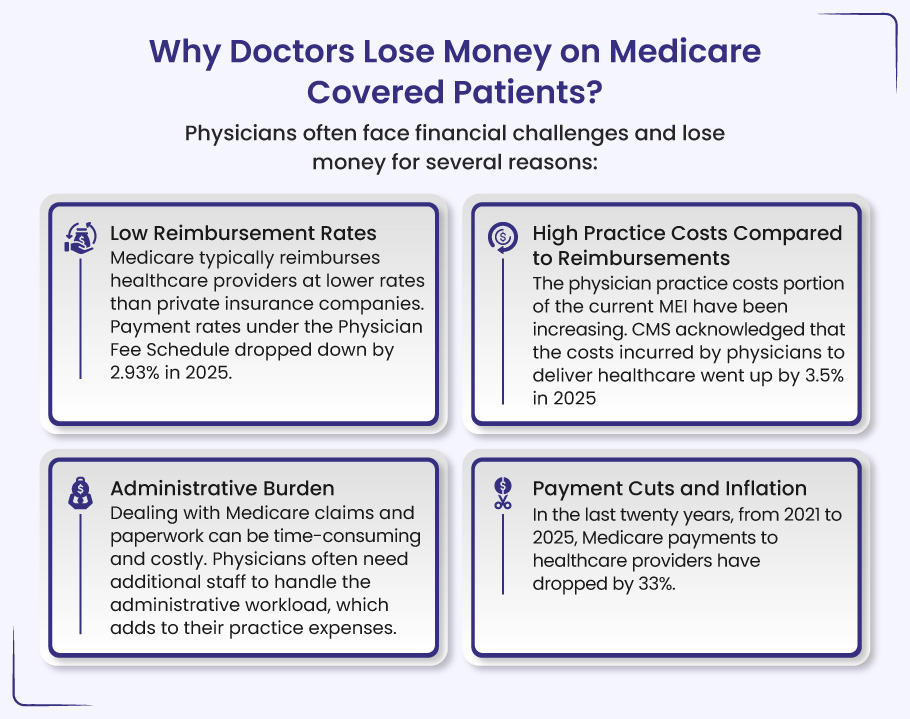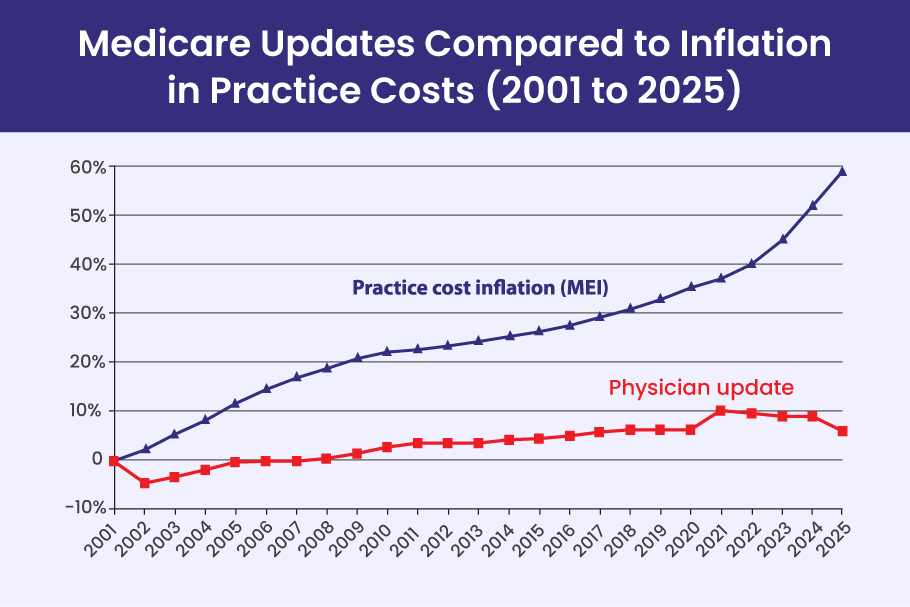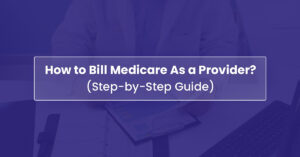More and more patients in America rely on Medicare to cover their healthcare as they age. Medicare provides health insurance coverage for 20% of the U.S. population, totaling approximately 67 million adults. But sometimes, patients are unable to find physicians because Medicare reimbursement rates are too low to cover their healthcare expenses, as physicians claim.
Physicians usually avoid providing health care services to Medicare patients—those of 65 years or older and some younger people with disabilities. Because Medicare offers low reimbursement rates.
The Medicare reimbursements are even insufficient to cover practice costs. As a result, the doctors lose money on Medicare patients.
Furthermore, it also causes a decrease in revenue for healthcare practices as they likely treat fewer patients because of low Medicare reimbursement rates for physicians.
However, while some doctors do not lose money on Medicare patients, they often face challenges affecting their performance of practice sustainability, and they face financial strains.
Here, we discuss the reasons why doctors lose money on Medicare patients and are reluctant to provide services to Medicare patients.

🌟 Stop Losing Money
on Medicare Patients TODAY
Chances are you’re underbilling Medicare and missing out on revenue. Our billing experts specialize in optimizing Medicare claims so you get paid your full rates. Start recouping more from Medicare this month.
Why Do Doctors Lose Money on Medicare Patients?
Physicians often face financial challenges and lose money for several reasons when providing care services to Medicare patients:

1️⃣ Low Reimbursement Rates
Medicare typically reimburses healthcare providers at lower rates than private insurance companies. This means that the payments physicians receive for healthcare services provided to Medicare patients may not cover the full cost of care, or sometimes, doctors face deficits while managing their practices’ expenses. However, Medicare offers low reimbursements but provides stability and predictability in payments.
Payment rates under the Physician Fee Schedule dropped down by 2.93% in 2025, which went into effect on January 1, compared to 2024 rates. As a result, the conversion factor will decrease from $33.29 in 2024 to $32.35 in 2025, a reduction of $0.94 (2.83%).
In addition, one reason for avoiding treating Medicare patients is affordable care. CMS Administrator Chiquita Brooks-LaSure said, “CMS remains committed to delivering affordable, high-quality care to all Americans while continually driving innovation to help better meet the individual needs of every person with Medicare.” As a result, physicians should expect less from CMS to pay for services provided to Medicare Patients.
2️⃣ High Practice Costs Compared to Reimbursements
The physician practice costs portion of the current MEI includes components for non-physician compensation (including fringe benefits), medical supplies, professional liability insurance, and other expenses (including other professional services, salaries for staff, and overhead expenses). They have been increasing. These rising costs can make it difficult for physicians to break even or profit when providing healthcare services to Medicare-covered patients.
CMS acknowledged that the costs incurred by physicians to deliver healthcare went up by 3.5% in 2025, as determined by the Medicare Economic Index (MEI). However, as CMS finalized the 2025 Medicare physician pay schedule, there will also be a 2.85% cut in pay. This proportion of pay cuts and cost rise can significantly impact practice revenue. Therefore, physicians are less likely to accept Medicare patients.
Increasing costs make it harder for physician practices running on small margins to acquire new equipment, retain staff members, and keep doors open for new Medicare patients. If the gap between what Medicare pays physicians and what it costs to provide high-quality care continues to grow, it will limit access to healthcare for senior Americans and persons with disabilities.
3️⃣ Administrative Burden
Dealing with Medicare claims and paperwork can be time-consuming and costly. Physicians often need additional staff to handle the administrative workload, which adds to their practice expenses. Furthermore, physicians spend considerable time on administrative tasks such as filling out forms, managing electronic health records (EHRs), and complying with regulatory requirements. This time away from patient care means fewer billable hours, directly impacting their income.
Many practices need to hire additional staff, such as medical billers, coders, and administrative assistants, to handle the administrative workload. These additional salaries and benefits add to the practice’s overall operating costs.
4️⃣ Payment Cuts and Inflation
Over the years, multiple cuts to Medicare reimbursement rates have been made, further reducing physicians’ income from treating Medicare patients. For example, in the last twenty years, from 2021 to 2025, Medicare payments to healthcare providers have dropped by 33% after accounting for rising costs, making it harder for doctors to care for their Medicare-covered patients.
“This actual dollar amount is something that physicians have to sort of fight for year after year. It’s a constant issue with reimbursement. If you look at how physicians have been reimbursed since 2001, once you’ve adjusted for inflation, there’s been a 30 percent decrease in physician reimbursement for Medicare patients,” Dr. Chang.
The table below shows the comprehensive details of practice cost inflation according to MEI and physician payments according to the Physician Fee Schedule (PFS).
Medicare Updates Compared to Inflation in Practice Costs (2001 to 2025)
Moreover, here we mention some crucial reasons physicians are less likely to accept Medicare patients:
- Medicare pays doctors about 80% of the “reasonable charge” for services it covers. At the same time, private insurance companies pay almost twice what Medicare pays for hospital services.
- CMS releases the Physician Fee Schedule each year. Medicare physicians must be participating providers by agreeing to the PFS and not charging more than the amount. However, non-participating providers can charge up to 15% more. Participating providers accept Medicare’s approved amount as full payment and bill Medicare directly. In contrast, non-participating providers can charge up to 15% more than the agreed amount and require patients to pay upfront.
- It can often take months for physicians to receive their payments. However, sometimes, they can receive payment within 14 days after electronic claim filing and within 28 days after paper filing.
- The estimated loss of Medicare claims due to billing problems is 7.3%. The loss is reduced to an estimated 4.8% with private insurers.

Do Physicians Really Lose Money on Medicare Patients?
According to the NYT, it is not always correct that doctors lose money on Medicare patients. Many physicians claim that insurance companies are not paying enough for doctors for care services they provide to seniors or disabled residents—Medicare-covered patients. As Dr. Barbara L. McAneny claims, “Insurers in the New Mexico exchange reimburse doctors at Medicare levels, which were ‘often below our cost of doing business, and definitely below commercial reimbursement rates.”
However, this claim seems doubtful since many doctors accept Medicare patients. Doctors earn over $200,000 annually, putting them in the top 1% of earners. Because they make so much money and work hard to keep out competition, it is hard to believe that many doctors would want to lose money by treating Medicare patients.
However, doctors receive less than expected pay when they provide healthcare services to Medicare patients. It is baseless to say that they completely lose money.
Some key points show how accepting Medicare patients can benefit healthcare providers:
- Doctors can manage their practices more efficiently to offset lower Medicare reimbursements. This might include reducing overhead costs, optimizing scheduling, and leveraging technology to streamline operations.
- Accepting Medicare patients can increase the volume of patients seen, which might compensate for lower individual reimbursement rates. Higher patient volume can lead to increased revenue overall.
- Physicians who accept Medicare patients may be eligible for certain tax deductions and benefits that can help offset the financial impact of lower reimbursements.
- There are ongoing discussions and potential legislative changes aimed at increasing Medicare reimbursements.
- Some healthcare models, such as Accountable Care Organizations (ACOs), provide additional incentives for providing comprehensive care to Medicare patients. These models can offer financial rewards for meeting certain quality and efficiency benchmarks.
When Doctors Avoid Medicare Patients: The Impact on Access & Care Quality
When doctors avoid accepting Medicare patients due to financial constraints, it can have significant impacts on both patient access and care quality.
Reduced Access to Care
Many Medicare patients, especially those in rural or underserved areas, may find it challenging to find physicians willing to accept them. This can lead to longer wait times for appointments and increased travel distances to see a doctor.
Quality of Care
With fewer doctors available to treat Medicare patients, the quality of care may suffer. Physicians may have less time to spend with each patient, potentially leading to rushed appointments and less personalized care.
Health Outcomes
Limited access to care can result in delayed diagnoses and treatment, which can worsen health outcomes for Medicare patients. Chronic conditions may go unmanaged, leading to more severe health conditions over time.
Financial Strain on Practices
Physicians who continue to accept Medicare patients may face financial strain due to lower reimbursement rates, which can impact their ability to invest in new technologies and maintain high-quality care standards.
Overall, the avoidance of Medicare patients by doctors can create a ripple effect, impacting not only individual patients but also the broader healthcare system. It’s a complex issue that requires thoughtful solutions to ensure that all patients receive the care they need.

Are You Owed More From Medicare?
Find Out Now
Even the most diligent practices underbill Medicare. Let our billing experts analyze your claims data and uncover any missed revenue opportunities. We’ll ensure you receive every penny Medicare owes you.
AMA Smoothen Ways for Physicians—Policy and Solutions
Since January 1, doctors have been paid 2.83% less than in 2024 for treating Medicare patients. This is the fifth year in a row that Medicare has cut payments for doctors. Along with not adjusting for rising costs, this is making it very hard, or even impossible, for some doctors to keep their practices running and care for aged patients.
During a webinar, Todd Askew, the senior vice president of AMA advocacy, mentioned that in 2025, the American Medical Association is working toward reversing the 2.83% cut that took effect on January 1 and is aiming for an annual increase tied to inflation. He emphasized the need for bipartisan support in a closely divided Congress, where Republicans have a narrow majority, to achieve these goals and address the key issues faced by patients and physicians.
Further, he explained that their advocacy has consistently prioritized bipartisanship. He noted that nearly every piece of legislation they have supported in the last several Congresses has been bipartisan, as they aim to build support from the center outward.
A bipartisan group of 10 House members introduced a bill in late January to prevent a 2.83% cut in Medicare payments to doctors this year and to give a 2% payment increase. The American Medical Association (AMA) fully supports this bill and will help include it in future laws to fund the government before the March 14 deadline.
Furthermore, Greg Murphy, MD (R-N.C.), and Jimmy Panetta (D-Calif.), along with eight other House members, introduced a bill called H.R. 879, the Medicare Patient Access and Practice Stabilization Act. This bill, starting on April 1, would cancel the 2.83% cut that began on January 1. Similar bills had support from both parties, but Congress did not deal with this issue during the last session.
👉 AMA’s Reforms
In addition, The American Medical Association (AMA) has been advocating for reforms to the Merit-based Incentive Payment System (MIPS) as AMA proposes a new Data-Driven Performance Payment System that aims to:
- Lower the maximum penalty from -9% to -0.5% of a physician’s annual payment update.
- Streamline reporting requirements and recognize quality efforts across performance categories.
- Provide more flexibility and support for small, rural, and safety-net practices.
- Adjust payments based on inflation rates to ensure that physicians are compensated fairly as the cost of living rises.
- Ensure that physicians’ income keeps pace with inflation, preventing a decrease in real income over time.
- Provide a more predictable and stable revenue stream for physicians, which can help them manage financial risks better.
👉 Telehealth Flexibilities and Equity Initiatives
Telehealth has become a crucial tool, especially during the COVID-19 pandemic. The AMA has outlined several steps to ensure equitable access to telehealth services, including:
- Providing internet-connected devices and broadband access to underserved communities.
- Ensuring telehealth solutions are user-friendly and accessible to people with varying levels of digital literacy.
These initiatives aim to address the financial challenges faced by physicians while ensuring that patients continue to receive high-quality care.
Final Words
Doctors treating Medicare patients often face tough financial challenges. While some wonder if they lose money, many say low payments and high costs make it hard to keep up. This leaves some patients struggling to find care. We looked at both sides of this issue and offered solutions to help both doctors and patients.





